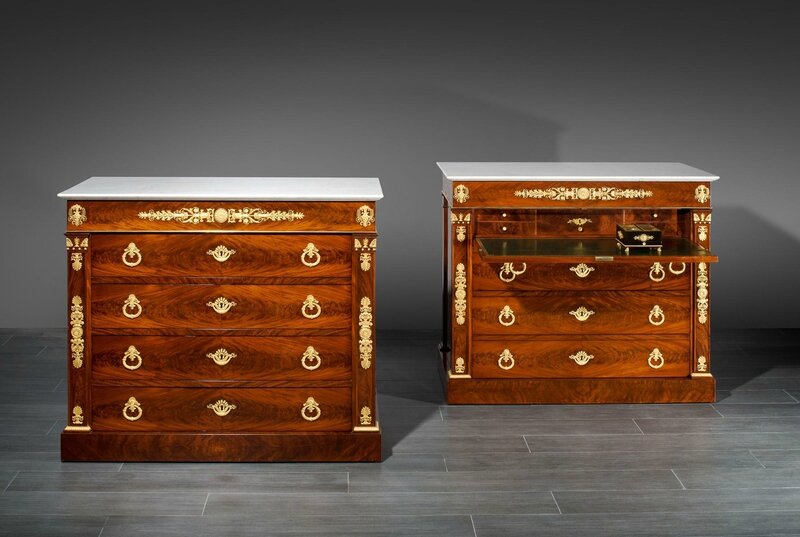A Pair of French Empire Gilt-Bronze Mounted Mahogany Commodes, one forming a secrétaire, attributed to Pierre-Benoît Marcion, Ci
A Pair of French Empire Gilt-Bronze Mounted Mahogany Commodes, one forming a secrétaire, attributed to Pierre-Benoît Marcion, Circa 1810. Photo courtesy Pelham London.
Height: 104 cm (3 ft. 5 in.). Width: 120 cm (3 ft. 11 ¼ in.). Depth: 60.5 cm (2 ft.)
The stepped moulded white marble tops above a frieze drawer richly mounted with acanthus, fritillary and rosette scrolls flanked by cornucopiae masks, above four drawers with scrolled escutcheon and ring drawer pulls flanked by moulded raised pilasters on three sides with rich anthemion and acanthus scroll mounts raised on a plain rectangular plinth, the upper drawer of one with a fall front opening to reveal a leather writing surface and internal arrangement of five small drawers.
Although unsigned, this rare pair of commodes is manifestly the product of a pre-eminent Parisian cabinetmaking workshop of the early 19th century, as evidenced by their superior mahogany veneers, sophisticated gilt bronze mounts and elegantly understated architectonic proportions. Stylistically they correspond to some of the finest work of Pierre-Benoît Marcion (1769-1840), one of the leading ébénistes of the Empire period and in terms of both quality and quantity the most important supplier to the Napoleonic Court after Jacob-Desmalter. In particular, the highly distinctive moulded corner pilasters on two sides, of deliberately simple form to allow maximal space for the display of the exquisitely refined mounts, are infrequently encountered on case furniture of the period, but appear on two commodes by Marcion sent to the Chambre à coucher de l’Impératrice at the Petit Trianon (now divided between the Grand Trianon and the Assemblée Nationale) and a single commode in the Chambre à coucher du Roi de Rome at Compiègne (illustrated in Jean-Pierre Planchon, Marcion, ébéniste de Napoléon, Saint-Rémy-en-L’Eau 2007, p.25, 86-87, 177). The incorporation of a secrétaire drawer into one of the commodes is also unusual, although it does appear on a mahogany commode stamped Marcion sold Koller Zürich, 8 December 2011, lot 1334.
Born in Paris in the Faubourg Saint-Antoine, Marcion is first mentioned professionally in 1798 as a Marchand Ébéniste operating from the boutique Aux Égyptiens in the Rue Neuve des Petits Champs. In 1801 he received his first official commission for a set of eighty-two 'curule' chairs in mahogany and marquetry for the Consular Senate, of which forty-nine still survive in the Palais du Luxembourg (one ill. in Planchon, p.18). In 1805 he began working for the Garde-Meuble Impérial and over the following seven years proceeded to supply a significant quantity of case and seat furniture to the newly-refurnished palaces of Saint-Cloud, Fontainebleau, Compiegne, and the Grand Trianon, often commanding higher prices than his rival Jacob-Desmalter. He also received commissions from prominent generals and members of Napoleon's court, including Eugene de Beauharnais, Murat, Moreau and Talleyrand. After the fall of Napoleon in 1814 he ceased trading, but managed to sell the remainder of his finished stock in 1816 to the newly-restored Bourbon monarchy, who not only retained the Napoleonic interiors in their palaces but complemented them with similar pieces to preserve stylistic unity.
Interestingly, from 1807 the Garde-Meuble records refer to Marcion not as an ébéniste but rather a fabricant de meubles et de bronzes, suggesting that like Jacob-Desmalter, Marcion ran a sufficiently large workshop to have an in-house bronzier to produce his own mounts without needing to resort to the usual practice of subcontracting them. Of particular note among Marcion’s bronzes are the vertical friezes of bellflowers or fritillaries that appear on the pair of commodes sent to the Petit Trianon, a floral motif that also appears in the frieze mounts on the present commodes. Fritillaries held especial significance in the ornamental repertory of the Empire style, as their elegant symmetry symbolized the Imperial Crown. They appeared as decorative elements primarily in textile design and were extremely rare in bronze (see L’Aigle et le Papillon, Symboles des pouvoirs sous Napoléon, exhibition catalogue, Musée des Art Décoratifs, Paris 2007, p.60, 276, 292), and thus their presence further supports the attribution to Marcion.
Pelham London. MasterArt at TEFAF 2014 on stand 814. 14-23 march 2014 - http://www.masterart.com/

/https%3A%2F%2Fprofilepics.canalblog.com%2Fprofilepics%2F1%2F0%2F100183.jpg)
/https%3A%2F%2Fstorage.canalblog.com%2F03%2F02%2F119589%2F96711876_o.jpg)
/https%3A%2F%2Fstorage.canalblog.com%2F11%2F31%2F119589%2F94773502_o.jpg)
/https%3A%2F%2Fstorage.canalblog.com%2F20%2F83%2F119589%2F94772815_o.jpg)
/https%3A%2F%2Fstorage.canalblog.com%2F26%2F72%2F119589%2F75604929_o.jpg)
/https%3A%2F%2Fstorage.canalblog.com%2F59%2F60%2F119589%2F26458628_o.jpg)




/http%3A%2F%2Fstorage.canalblog.com%2F50%2F40%2F119589%2F121027920_o.png)
/http%3A%2F%2Fstorage.canalblog.com%2F04%2F88%2F119589%2F112498983_o.jpg)
/http%3A%2F%2Fstorage.canalblog.com%2F35%2F68%2F119589%2F111554846_o.jpg)
/http%3A%2F%2Fstorage.canalblog.com%2F80%2F74%2F119589%2F110526316_o.jpg)